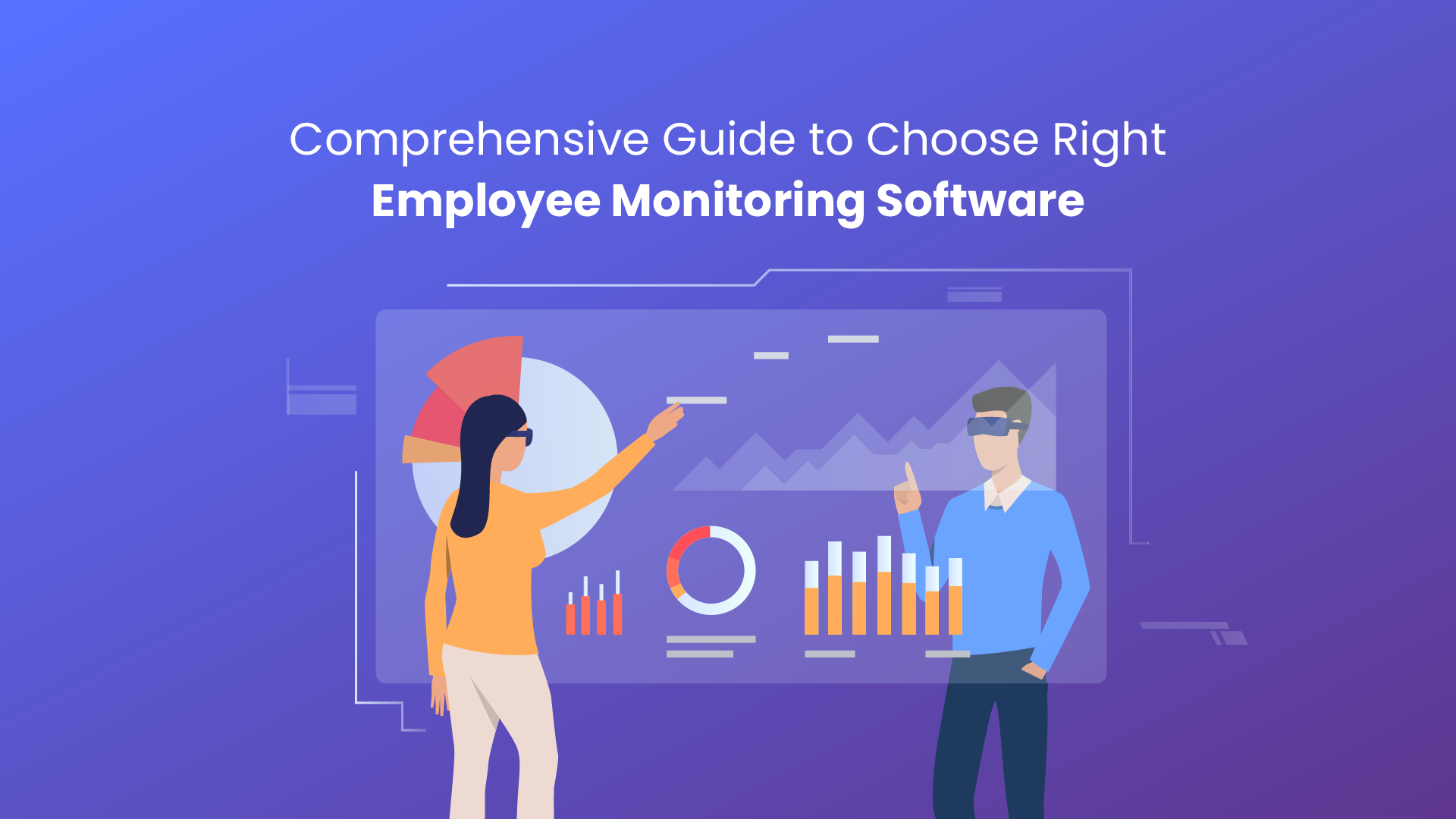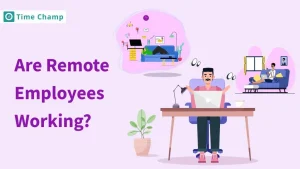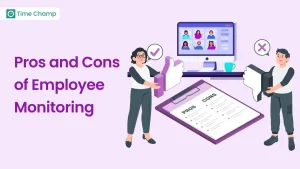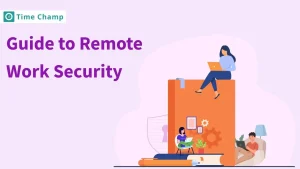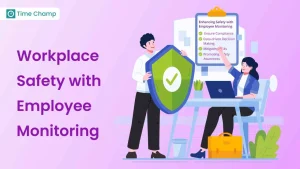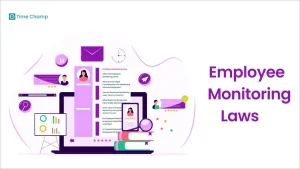To ease your decision-making process, we have curated a complete guide that will help you choose the right employee desktop tracking tool. Make sure to stick to the end of this blog to make the right decision.
What is Desktop Monitoring Software?
Desktop monitoring software is a technological approach that organizations use to record and study the activities and productivity of employees who are working with computers provided by the organization. The metrics such software can record include but are not limited to application usage, web activities, file audacity, and keystrokes.
Key functionalities of desktop monitoring software may include:
- Activity Tracking: It would include keeping track of the time employees spend on different applications or websites.
- Screenshot Captures: Randomly capture screenshots of what an employee is doing on his or her desktop at work.
- Keystroke Logging: Monitor keyboard activity
- User Behaviour Analytics: Analyses the data to discover outliers which are signs of issues, like a drop in output or threats related to cyber-security.
- Automated Alerts: Generates notifications for specific events such as accessing a restricted website by an employee or using prohibited software.
- Reporting Tools: Provide reports that take a summative state of the acquired data to facilitate decision-making by management about personnel productivity and computer use.
For instance, Time Champ has a special feature of checking employee tasks where the tasks and work items are checked automatically without requiring any recording manually. Such automatic tracking not only improves the efficiency of operations for employees and managers but also makes them more accurate. Time Champ drives the automatic creation of timesheets, includes additional tracking functionalities like screenshots and recordings, and provides task management instruments to allow employees to concentrate on their work without dealing with the tasks.
To support transparency, increase the efficiency of overall work, protect company assets, and contribute to efficient employee performance the desktop monitoring software is used. Companies employing such software need therefore to strike a balance between privacy protection and control over their employees in the legal context.
Why is Desktop monitoring software important?
Desktop monitoring software is of paramount importance for several reasons:
- Productivity Analysis: It helps in measuring and analyzing the productivity of employees by tracking how they spend their time during work hours. This includes monitoring the applications and websites they use, enabling managers to identify and address inefficiencies.
- Data Security: By monitoring desktop activity, companies can safeguard sensitive information and intellectual property. It helps in preventing unauthorized access and detecting potential insider threats.
- Compliance and Legal Protection: With stringent regulations in many sectors, desktop monitoring can ensure that employees are complying with legal and company policies, which can protect the organization from potential lawsuits and fines.
- Remote Work Management: Especially with the rise of remote work, desktop monitoring software has become crucial in managing a distributed workforce, ensuring that employees are engaged and productive no matter where they are working.
- Improved Resource Allocation: By understanding how employees interact with company resources, businesses can make informed decisions about software licenses, hardware updates, and other IT investments.
- Employee Development: Desktop monitoring provides insights into employee performance, which can be used for personalized training and development plans that help employees grow and succeed in their roles.
- Evidence-based Decision Making: With concrete data on hand, managers can make objective decisions concerning performance assessments, promotions, or even downsizing, if necessary.
Important Factors to Consider When Choosing the Best Desktop Monitoring Software
In today’s rapidly changing business world, where every keyboard stroke counts, the selection of desktop monitoring software or laptop monitoring software becomes a critical decision for companies seeking to improve efficiency, guarantee data security, and standardize processes. Therefore, in this guide, we dive into the essential points that require your consideration while choosing the best desktop monitoring software.
1. Compatibility with Operating Systems:
While most businesses use Windows, there are so many that opt for MacOS or Linux. It is important to have your hands on software that is compatible with multiple operating systems. This compatibility will ensure that your software is reliable and works seamlessly without any disruptions.
2. Real-Time Activity Tracking:
Employee computer monitoring software like Time Champ will provide you with real-time activity tracking of the employees. This means that you will have access to all the activities that your employees have done right from the time they have logged in. Time Champ divides the time spent on the computer into three categories- Productive, Unproductive, and neutral. You will know how much time your employee spends productively, the unproductive apps and websites they have accessed, along their neutral time.
3. Screenshots and Video Recording:
Snapping screenshots and creating video recordings are like taking snapshots and making movies of what employees do on their computers. It’s a handy tool for checking their work and fixing any issues, but it’s crucial to use it carefully. We need to find the right balance between keeping an eye on productivity and respecting the privacy of our hardworking team members. It’s like having a watchful eye without intruding too much.
4. Keystroke Logging and Mouse Click Tracking:
Keystroke logging records the keystrokes made by employees, allowing you to view the content of their typed messages. This feature can be sensitive due to privacy concerns, so its use should be carefully considered and communicated to employees.
Apart from keystroke logging, Time Champ also provides you with mouse click tracking. You can use this feature.
|Remote access and control enable administrators to remotely view and control an employee’s desktop. It aids in providing technical support and resolving issues efficiently, especially in remote work scenarios.
5. Remote Access and Control:
Enable your IT team with superhero capabilities through Time Champ’s remote access and control feature. It acts as a powerful tool for providing support, troubleshooting issues, and ensuring seamless operations, especially in remote work scenarios.
6. Data Security and Privacy Features:
Robust data security and privacy features are essential. Encryption ensures that the collected data remains confidential. Secure data storage prevents unauthorized access. Role-based access controls limit who can view and manage monitoring data.
7. Scalability for Growing Organizations
Scalability is crucial for organizations expecting growth. The software should handle an increasing number of monitored devices and users without compromising performance. Ensure that the software’s architecture and capabilities can accommodate your organization’s expansion. Time Champ flexibilities grow along with your organization.
8. User-friendliness and Ease of Deployment:
The software should have an intuitive user interface that simplifies configuration and monitoring. Easy deployment reduces the learning curve for administrators and ensures swift implementation across the organization.
9. Integration with Other Tools and Software:
Integration with existing tools and software streamlines workflows and enhances the monitoring’s effectiveness. Consider whether the software can connect with project management, time tracking, or employee management systems to provide a comprehensive overview of productivity and performance.
Time Champ is capable of integrating with most of the software and tools that are being used in an organization. Right from project management tools like Trello to HR software like Keka, the tool can be integrated with various other tools.
If you are not using any of the business tools that are available in the market, you can leverage in-built features like the HR tool and project management tool in Time Champ itself. Our cutting-edge features have helped so many organizations already.
Implementation of Desktop Monitoring Software in Your Organisation
Whenever Desktop monitoring software is introduced to employees, they feel intimidated. However, on the other side, if you do processes one by one and implement with full concentration to your employees no stopping point is available.
1. Clearly Define Monitoring Goals and Objectives:
This will help identify the main objectives of implementing workstation monitoring. Be it increased productivity, better compliance, or security; setting goals will drive your monitor strategy and show the success level.
2. Select the Appropriate Software:
Opt for computer monitoring software that is compatible with the goals and needs of your organization. Factors you may need to consider are compatibility with your systems, general functions that have been desired, and most importantly costs. Assess various software interfaces and decide after a reasonable choice.
3. Obtain Employee Buy-In:
Let your employees know about the purpose of monitoring clearly and transparently. Describe the advantages, for example increasing efficacy and security. This will help you to identify and treat any concerns they may have while stressing the fact that the monitoring is not for micromanagement but for better improvement of performance.
4. Communicate Transparently:
Develop a clear and concise communication strategy. Inform employees beforehand that monitoring will be adopted, the reason for this decision, what data will be gathered and how it is going to be used. Emphasize the policies that are supposed to protect their privacy and convince them that monitoring is intended only for work-related purposes.
5. Create and Implement Monitoring Policies and Guidelines:
Establish clear monitoring policies that specify which aspects are monitored at what time and how the provided information will be applied. Delineate the area of monitoring, allowed activities, and any possible measures that can have been undertaken using the received data. Make these policies equitable and realistic, and align them with key statutes.
6. Provide Training and Support for Employees:
Educate employees on the operations of the particular software used in monitoring and how to utilize it within acceptable limits. During training sessions answer their questions and clear the air with any other concerns that they may have. Provide them with continued assistance to ensure that they can effectively use the software and feel at ease while monitoring.
7. Implement Monitoring Gradually:
If feasible, introduce monitoring slowly so that the employees can adapt to it. It also makes it easy for you to detect challenges early and solve them before full deployment.
8. Regularly Review and Optimise Monitoring Strategies:
Periodically monitor the monitoring details and determine if it supports your budget goals. Employ the understanding to uncover patterns, bottlenecks, and areas for betterment. To do a better job, you need to modify your strategies in the area of monitoring using this feedback.
9. Address Employee Concerns and Feedback:
Establish mechanisms through which employees can raise their issues and opinions about the monitoring system. Pay attention to what they have to say, and if there are valid issues or suggestions, make those changes.
10. Balance Privacy and Productivity:
Seek to ensure balance on monitoring for efficiency and that of preserving the employee’s privacy. Do not use too much monitoring because it can create a sense of mistrust or foster feelings of revenge in workers. Avoid getting into the details, instead focus there on achieving results and improvements.
11. Regularly Review and Update Policies:
Reassess the policy guidelines over time to ensure they are updated as your organization evolves and policies keep changing. This guarantees that your practices in monitoring are conducted within ethical consideration, comply with the necessary standards, and concur with the values of your establishment.
As you can see, desktop monitoring software should have a myriad of features to help your organization. One software that comes with all of these features, along with the future trends that you have seen above, is Time Champ.
Time Champ is a coming-age software, and so many organisations have been relying on it. If you are looking to invest in good employee and productivity monitoring software, then book a demo now.
Conclusion
Desktop and laptop monitoring software has emerged as an essential component for modern businesses seeking to optimize productivity, safeguard data, and maintain a competitive edge. By providing a comprehensive picture of employee activity, these monitoring solutions empower organizations to make informed decisions that drive efficiency and ensure the optimal use of resources.
Generally, the importance of desktop monitoring software is in its various aspects. Being a tool for typical product analysis, it provides with in-depth understanding of the place and method where employees spend their time. It also enhances data security by detecting risky behaviours and possible breaches before they occur. It helps to optimize the processes of compliance with normative-legal and regulatory standards since tracking is detailed, and leaders are more capable of guiding remote teams.
Also Read
What is Employee Monitoring? Everything You Need to Know
How to Detect Mouse Jiggler Activity in the Workplace?
FAQs
Desktop monitoring software is a tool used by organizations to oversee computer usage, ensuring employees are productive and adhere to company policies.
It provides data on how employees spend their work time, allowing for optimization of tasks and improvement of time management.
Yes, it is legal when employees are informed and the software is used in compliance with privacy laws and company regulations.
Absolutely, it is particularly beneficial for remote workers, helping to manage and track their productivity effectively.
Look for user-friendliness, customizability, scalability, integration capabilities, and compliance with privacy regulations.
Yes, TimeChamp.io provides flexible settings to tailor the monitoring to your specific business needs.
Real-time tracking, automated timesheets, productivity analytics, and seamless integration with other tools.
Monitor only during work hours, be transparent about policies, and focus on productivity rather than personal activities.
Not if used responsibly. It should focus on work-related activities, and employees should be aware of monitoring measures.
Yes, the objective data collected can provide a fair assessment of employee performance over time.
